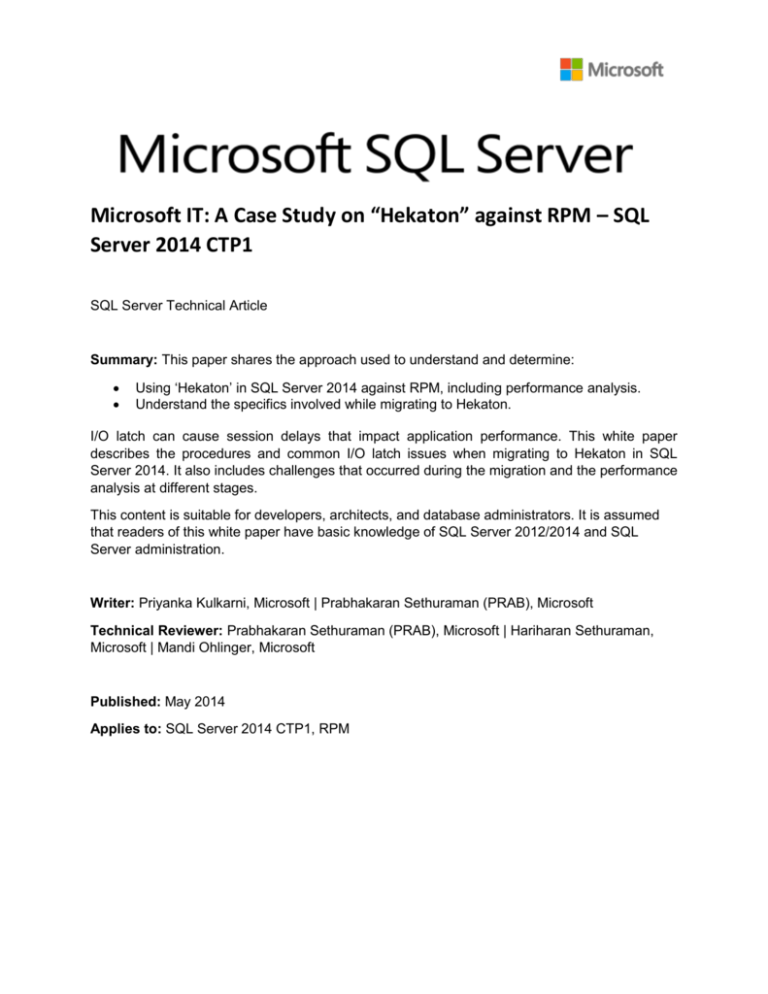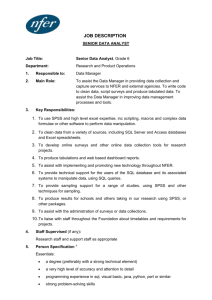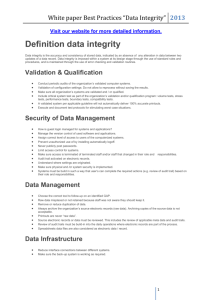
Microsoft IT: A Case Study on “Hekaton” against RPM – SQL
Server 2014 CTP1
SQL Server Technical Article
Summary: This paper shares the approach used to understand and determine:
Using ‘Hekaton’ in SQL Server 2014 against RPM, including performance analysis.
Understand the specifics involved while migrating to Hekaton.
I/O latch can cause session delays that impact application performance. This white paper
describes the procedures and common I/O latch issues when migrating to Hekaton in SQL
Server 2014. It also includes challenges that occurred during the migration and the performance
analysis at different stages.
This content is suitable for developers, architects, and database administrators. It is assumed
that readers of this white paper have basic knowledge of SQL Server 2012/2014 and SQL
Server administration.
Writer: Priyanka Kulkarni, Microsoft | Prabhakaran Sethuraman (PRAB), Microsoft
Technical Reviewer: Prabhakaran Sethuraman (PRAB), Microsoft | Hariharan Sethuraman,
Microsoft | Mandi Ohlinger, Microsoft
Published: May 2014
Applies to: SQL Server 2014 CTP1, RPM
Copyright
This document is provided “as-is”. Information and views expressed in this document, including URL and
other Internet Web site references, can change without notice. You bear the risk of using it.
This document does not provide you with any legal rights to any intellectual property in any Microsoft
product. You can copy and use this document for your internal reference purposes.
© 2014 Microsoft. All rights reserved.
Contents
Contents ................................................................................................................................................ 3
Introduction .......................................................................................................................................... 4
About SQL Server 2014 ......................................................................................................................... 4
Understanding Hekaton ........................................................................................................................ 5
What is RPM? ........................................................................................................................................ 6
Performance issues in RPM .................................................................................................................. 7
Hekaton as a solution............................................................................................................................ 7
RPM to Hekaton Migration Case Study ................................................................................................ 8
Context ............................................................................................................................................. 8
Objectives ........................................................................................................................................ 9
Environments for performance analysis .......................................................................................... 9
Identification of Top 5 scenarios...................................................................................................... 9
Performance analysis after vanilla migration to SQL Server 2014 .................................................. 9
AMR Report: Identification of the top candidate table for migration ........................................... 11
Migration to Hekaton .................................................................................................................... 12
Procedure.......................................................................................................................... 12
Challenges ......................................................................................................................... 13
Post Migration Analysis....................................................................................................................... 15
Conclusion ........................................................................................................................................... 17
Appendix ............................................................................................................................................. 17
Acknowledgements............................................................................................................................. 17
Introduction
In-Memory OLTP (formally known as “Hekaton”) is a new database engine component fully integrated
into SQL Server 2014. It is optimized for OLTP workloads that access memory resident data. In-Memory
OLTP allows OLTP workloads to achieve remarkable performance improvements and reduce processing
time. Tables can be declared as ‘memory optimized’ to take advantage of In-Memory OLTP capabilities.
This paper describes the following:
Using "Hekaton" in SQL Server 2014 against RPM, including performance analysis.
Understanding challenges faced, the solutions drawn, and the improvement in the migration
process.
I/O latch can cause session delays that impact application performance. This white paper describes the
procedures and common I/O latch issues when migrating to Hekaton in SQL Server 2014. It also includes
challenges that occurred during the migration and the performance analysis at different stages.
This content is suitable for developers, architects, and database administrators. It is assumed that
readers of this white paper have basic knowledge of SQL Server 2012/2014 and SQL Server
administration.
About SQL Server 2014
At SQL PASS in November 2012, it was announced that In-memory OLTP (code-named Hekaton)
database technology is built into the next release of SQL Server. The latest release of the SQL Server
2014 Database Engine introduces new features and enhancements that increase the power and
productivity of architects, developers, and administrators who design, develop, and maintain data
storage systems. There are multiple areas in which the Database Engine has been enhanced, including:
Database Engine Feature Enhancements
Memory-Optimized Tables
SQL Server Data Files in Windows Azure
Host a SQL Server Database in a Windows Azure Virtual Machine
Backup and Restore Enhancements
New Design for Cardinality Estimation
Delayed Durability
AlwaysOn Enhancements
Partition Switching and Indexing
Managing the Lock Priority of Online Operations
Columnstore Indexes
Buffer Pool Extension
Incremental Statistics
Resource Governor Enhancements for Physical IO Control
Online Index Operation Event Class
Database Compatibility Level
Transact-SQL Enhancements
System View Enhancements
Security Enhancements
Deployment Enhancements
In this paper, the main focus is on the memory optimized tables. “Hekaton” is the code name for InMemory OLTP. These two terms are used interchangeably in this paper.
Understanding Hekaton
Figure 1: The SQL Server engine includes the In-Memory OLTP component
Memory-optimized tables
When memory-optimized tables are accessed, pages are not read into cache from disk. All the data is
stored in memory, all the time. A set of checkpoint files (used for recovery purposes) is created on
filestream filegroups that track changes to the data. The checkpoint files are append-only.
Operations on memory-optimized tables use the same transaction log used for operations on disk-based
tables. The transaction log is stored on disk. In a system crash or server shutdown, the rows of data in
memory-optimized tables can be recreated from the checkpoint files and the transaction log.
In-Memory OLTP provides the option to create a table that is non-durable and not logged using the
SCHEMA_ONLY option. As the option indicates, the table schema is durable, even though the data is not.
[1]
Indexes on memory-optimized tables
SQL Server 2014 introduces hash indexes for memory-optimized tables. Hash indexes are very efficient
for point lookup operations. Hash indexes require a simple lookup in a hash table rather than navigating
an index tree structure; which is required for traditional (non) clustered indexes. If you are looking for
the rows corresponding to a particular index key value, using a hash index is the way to go. Every
memory-optimized table must have at least one Hash index. Because of the nature of hash tables, rows
appear in the index in random order.
Indexes are never stored on disk and are not reflected in the on-disk checkpoint files. Operations on
indexes are never logged. The indexes are maintained automatically during all modification operations
on memory-optimized tables; just like B-tree indexes on disk-based tables. In a SQL Server restart, the
indexes on the memory-optimized tables are rebuilt as the data is streamed into memory. [1]
Concurrency improvements
When accessing memory-optimized tables, SQL Server uses optimistic multi version concurrency control.
Although SQL Server supports optimistic concurrency control with the snapshot-based isolation levels
introduced in SQL Server 2005, these optimistic methods acquire locks during data modification
operations. For memory-optimized tables, there are no locks acquired, and thus no waiting because of
blocking.
When using memory-optimized tables, it is still possible to experience waiting. There are other wait
types, such as waiting for a log write to complete. However, logging while updating memory-optimized
tables is much more efficient than logging for disk-based tables. Wait times are much shorter. And,
there are no waits for reading data from disk and no waits for locks on data rows. [1]
Feature Set
The best execution performance is obtained when using natively compiled stored procedures with
memory-optimized tables. However, there are limitations on the TSQL language constructs allowed
inside natively compiled stored procedures compared to the rich feature set available with interpreted
code in the TSQL language. In addition, natively compiled stored procedures can only access memoryoptimized tables and cannot reference disk-based tables. [1]
What is RPM?
The Resource and Project Management (RPM) application is a Microsoft IT LOB application. RPM
automates much of the resource management functionality. But it does not replace the level of
communication required among RMs, EMs, and Team Members for Resource Management to be
effective. The RPM application includes the following:
Allows RMs visibility to meet demand through resource requests. RMs are able to match a
resource to an engagement based on different criteria, such as Skill and Availability. RM’s are
able to view global and local, resources and can request global assistance if needed.
Allows requestors and RMs provide a clear description of requirements for an engagement and
view the progress and status of resource requests and bookings.
Allows PDMs to tailor the training of consultants to the needs of the market by providing supply
and demand data.
View various reports that track lead time, how quickly requests are being filled, bench time, and
many other factors.
The various systems that interact with RPM include the following:
Account
Master
Contract
System
Downstream
Reporting
Systems
RPM
Users
Vacation Plan
System
Skills Master
System
Figure 2: Interaction of systems used within services business
Performance issues in RPM
In FY13, after tuning performance on the DEV box, there is an average 40-50% improvement in the
following interfaces:
Request Get
Bookings Get
Project Search
However, the I/O latch waits continued to affect RPM performance. I/O latch waits occur when a needs
to wait for a page due to physical I/O. For example, a page is made available in the buffer pool for
reading or writing and SQL Server needs to retrieve it from disk.
In this situation, sessions experienced delays; hindering RPM performance.
Hekaton as a solution
After analyzing the performance issues faced by RPM and considering the benefits Hekaton, Hekaton is
explored as a solution to the performance concerns.
Figure 3: Understanding the performance gains
Hekaton is an ideal solution to latch-based performance difficulties for following reasons:
•
Memory-optimized tables (Hekaton) are stored differently than disk-based tables
•
Efficiency in accessing and processing data
•
No locks acquired, and thus no waiting because of blocking
•
Far less log data and needing fewer log writes
RPM to Hekaton Migration Case Study
Context
Resource Management is responsible for matching resources to projects; ensuring the right consultants
on the right projects at the right time. It is a managerial process that directly affects customer
satisfaction, business results, and the motivation, productivity, and professional development of the
consulting workforce. Resource and Project Management application automates as much of the
functionality of resource management as possible. It does not replace the level of communication
required among RMs, EMs, and Team Members in order for Resource Management to be effective.
Currently, the RPM database server uses SQL Server 2008 R2. Due to I/O latch waits, sessions experience
delays; decreasing RPM performance. In this white paper, we migrate to SQL Server 2014 with the
implementation of ‘Hekaton’ as a solution. We also share the challenges faced, the solutions, as well as
the improvements observed in the migration process.
Objectives
Perform a proof of concept that migrates the RPM database server from SQL Server 2008 R2 to
SQL Server 2014.
Leverage the ‘Hekaton’ feature of SQL Server 2014 to overcome the performance burden caused
by page I/O latch waits.
Execute extensive performance analysis over the existing and the to-be environments.
Explain the challenges faced and the improvements observed in the migration process.
Environments for performance analysis
The various performance analyses completed throughout the migration process used the following
three environments:
SQL Server
Server Name
RAM
Secondary
Memory
Location
2008
hyd2rxdssdev02
8 GB
230 GB
hyd
2014 - 1
hydrpmvm14
8 GB
100 GB
hyd
2014 - 2
hydrpmvm14 – with
Memory optimized
Schedule table
12 GB
100 GB
hyd
Table 1: SQL Server versions and complete system configurations under which the performance analyses is done
Identification of Top 5 scenarios
In order to execute the performance analysis of RPM in the existing (SQL Server 2008) and to-be (SQL
Server 2014) environments, five scenarios and their performance are evaluated:
1. Bookings search
2. Requests search
3. Resources search
4. Projects search
5. Project schedule search
The performance analysis in this white paper focuses on these five scenarios.
Performance analysis after vanilla migration to SQL Server 2014
At the first stage of analysis, there is a performance improvement in the five scenarios after a vanilla
migration to SQL Server 2014. Results include:
Bookings Procedure (result in minutes):
Version
State
Rows ret
Run 1
Run 2
Run 3
Run 4
Run 5
2008
Existing environment
16854
1:31
0:19
0:19
0:19
0:20
2014 - 1
Vanilla migration to 16890
SQL Server 2014 CTP1
0:46
0:18
0:19
0:18
0:16
Table 2: Performance (in minutes) for each run of Bookings Procedure in various environments
Requests Procedure (result in minutes):
Version
State
Rows ret
Run 1
Run 2
Run 3
Run 4
Run 5
2008
Existing environment
12474
0:49
0:20
0:17
0:17
0:21
2014 – 1
Vanilla migration to 12475
SQL Server 2014 CTP1
0:31
0:17
0:17
0:17
0:18
Table 3: Performance (in minutes) for each run of Requests Procedure in various environments
Resources Procedure (result in minutes):
Version
State
Rows ret
Run 1
Run 2
Run 3
Run 4
Run 5
2008
Existing environment
40906
2:24
0:34
0:28
0:26
0:31
2014 – 1
Vanilla migration to 40916
SQL Server 2014 CTP1
1:44
0:15
0:14
0:14
0:12
Table 4: Performance (in minutes) for each run of Resources Procedure in various environments
Projects Procedure (result in minutes):
Version
State
Rows ret
Run 1
Run 2
Run 3
Run 4
Run 5
2008
Existing environment
1064
0:16
0:16
0:01
0:01
0:01
2014 - 1
Vanilla migration to 1063
SQL Server 2014 CTP1
0:05
0:01
0:01
0:01
0:01
Table 5: Performance (in minutes) for each run of Projects Procedure in various environments
Project Schedule Procedure (result in minutes):
Version
State
Rows ret
Run 1
Run 2
Run 3
Run 4
Run 5
2008
Existing environment
459
0:08
0:00
0:00
0:00
0:00
2014 - 1
Vanilla migration to 459
SQL Server 2014 CTP1
0:05
0:00
0:00
0:00
0:00
Table 6: Performance (in minutes) for each run of Project Schedule Procedure in various environments
As you can see, there is an increase in performance even after a simple vanilla migration. This
performance improvement is attributed to the improved cardinality estimator in SQL Server 2014.
AMR Report: Identification of the top candidate table for migration
It can be difficult to determine which targets should take advantage of In-Memory OLTP. SQL Server
2014 CTP1 includes the AMR (Analysis, Migration, and Reporting) Tool to help decide which tables and
stored procedures can move to Hekaton or In-Memory OLTP. This tool is integrated with the Data
Collector.
Consider using the AMR Tool in the following scenarios:
Unsure which tables and stored procedures should migrate to In-Memory OLTP
Seeking validation for the migration plans
Evaluating the work needed to migrate tables and stored procedures
The following AMR report (Table usage) is generated and determines the most suitable candidate for
migration to Hekaton:
Figure 4: RPM AMR Report indicating ‘Schedule’ as the migration candidate
Graphically, it shows the best options for tables to transform to in-memory OLTP. The left axis indicates
‘Gain’. For example, how much you gain if you transform. The bottom axis indicates ‘Migration Work’.
For example, the work needed to transform. The best candidates for in-memory OLTP are listed in the
top-right of the graph. Based on the report, the ‘Schedule’ table is the best candidate for migration to
Hekaton. The Schedule table has Minimal migration work and high gain post- migration.
Migration to Hekaton
Procedure
1) Before creating memory optimized tables, create the file group and declare the database as memory
optimized:
ALTER DATABASE RPM ADD FILEGROUP rpm_mod CONTAINS MEMORY_OPTIMIZED_DATA;
GO
ALTER
DATABASE
RPM
ADD
FILE
(NAME='rpm_mod',
FILENAME='C:\RPMHekatonFilegroup\rpm_mod') TO FILEGROUP rpm_mod;
GO
2) Determine the bucket size and create the memory optimized table:
The Schedule table (candidate for migration in the AMR report) is converted to a memory-optimized
Schedule table. Only NON CLUSTERED HASH indices can be used in a memory optimized table. A hash
index consists of an array of pointers. Each element of the array is called a hash bucket. The bucket size
is chosen as equal to, or greater than the expected cardinality (the number of unique values) of the
index key column. There is a greater likelihood that each bucket only has rows with a single value in its
chain.
The memory optimized schedule table is created using the following:
CREATE TABLE [dbo].[Schedule]
(
[ScheduleID] [int] NOT NULL,
[BookingID] [int] NOT NULL,
[ResourceID] [int] NOT NULL,
[Date] [datetime] NOT NULL,
[Minutes] [int] NOT NULL,
[LastModifiedOnDate] [datetime] NOT NULL,
[LastModifiedByID] [int] NOT NULL,
[LastModifiedDate] [datetime] NULL
INDEX [IX_Schedule_BkId_ScheId] NONCLUSTERED HASH
(
[BookingID],
[ScheduleID]
)WITH ( BUCKET_COUNT = 33554432),
INDEX [IX_Schedule_Covering_Index] NONCLUSTERED HASH
(
[BookingID],
[ResourceID]
)WITH ( BUCKET_COUNT = 33554432),
INDEX [IX_ScheduleDate] NONCLUSTERED HASH
(
[Date]
)WITH ( BUCKET_COUNT = 33554432),
PRIMARY KEY NONCLUSTERED HASH
(
[ScheduleID]
)WITH ( BUCKET_COUNT = 33554432),
INDEX [ScheduleIX1D] NONCLUSTERED HASH
(
[ResourceID]
)WITH ( BUCKET_COUNT = 33554432),
INDEX [ScheduleIX2D] NONCLUSTERED HASH
(
[BookingID]
)WITH ( BUCKET_COUNT = 33554432),
INDEX [UI_DATE_RESOURCE_BOOKING] NONCLUSTERED HASH
(
[ResourceID],
[BookingID],
[Date]
)WITH ( BUCKET_COUNT = 33554432)
)WITH ( MEMORY_OPTIMIZED = ON , DURABILITY = SCHEMA_AND_DATA )
GO
When the new memory-optimized Schedule table is created, data from the non-memory optimized
Schedule table is inserted into this new table. The old Schedule table is dropped, renamed, and can be
used as backup. All further transactions on the Schedule table are performed on the new memoryoptimized version of the Schedule table. Since No UNIQUE indexes other than for the PRIMARY KEY are
allowed, the insertions are tracked by using Sequences.
Challenges
1) RAM size considerations
When the memory-optimized tables are accessed, pages are not read into cache from disk. All the
data is stored in memory, all the time; which is an important difference between memory-optimized
tables and disk-based tables. A set of checkpoint files (used only for recovery purposes) is created on
filestream filegroups that track changes to the data. The checkpoint files are append-only. Thus, monitor
the size of the memory optimized table and the RAM capacity. To help optimize performance, you can
modify the RAM available. If the SQL Server resides on a virtual machine, the amount of RAM is
configurable. To determine the new RAM size, use the following steps:
Measure OLTP size using sp_spaceused. This stored procedure gives the data plus the index size.
New RAM size = Old RAM + Memory Optimized table size
2) Reference constraints migration
When creating memory-optimized tables, no FOREIGN KEY or CHECK constraints are allowed. The
following procedures add the constraints to the memory-optimized tables:
IF EXISTS (SELECT 1 FROM BOOKINGS WHERE BOOKINGID=@BookingID
@ResourceID )
SELECT @Bookingsflag=1
AND RESOURCEID=
IF NOT EXISTS(SELECT ScheduleID
FROM Schedule WITH (SNAPSHOT)
WHERE BookingID = @BookingID
AND ResourceID = @ResourceID
AND [Date] = @Date) AND @Bookingsflag=1
AND @MSP_RESOURCES_EXTflag=1
BEGIN
INSERT Schedule(
BookingID
, ResourceID
, [Date]
, Minutes
, LastModifiedByID
, LastModifiedDate
)
VALUES(
@BookingID
, @ResourceID
, @Date
, ISNULL(@Hours, 0) * 60
, @LoggedInUserID
, GETUTCDATE()
)
END
ELSE
BEGIN
SET @ErrNo = 51104
Goto Crash
END
3) Indices Migration
When creating memory optimized tables, no UNIQUE indexes other than the PRIMARY KEY are
allowed. Also, range indexes are not available in CTP 1 (available in CTP2). As a result, all indices are
converted to NON CLUSTERED HASH indices.
4) Read isolation issue
READ_COMMITTED_SNAPSHOT is supported for memory-optimized tables with auto commit
transaction and only if the query does not access any disk-based tables. When accessing a memoryoptimized table from an explicit or implicit transaction that uses interpreted Transact-SQL, an isolation
level table is required. Therefore, all dependent procedures must include WITH (SNAPSHOT).
Post Migration Analysis
The post migration analysis is done at two levels: 1) Read level 2) Write level.
The procedures that have no dependencies on the memory optimized Schedule table show no
improvement in performance. Of the five scenarios, the following procedures are dependent on the
Schedule table and have improved performance:
•
Bookings Procedure
•
Resources Procedure
•
Get Project Schedule Procedure
Hekaton Read level performance:
At the read level, Bookings procedure demonstrated 187% improvement in first run:
Bookings Procedure
1:40
1:26
In Minutes
1:12
0:57
0:43
0:28
0:14
0:00
Run 1
Run 2
Existing environment : SQL Server 2008
Run 3
Run 4
Run 5
Vanilla migration to SQL Server 2014 CTP1
SQL Server 2014 with Hekaton
Figure 5: Performance (in minutes) of the Booking procedure in different environments
The Resources procedure demonstrated 215% improvement in first run:
Resources Procedure
2:24
In Minutes
1:55
1:26
0:57
0:28
0:00
Run 1
Run 2
Existing environment : SQL Server 2008
Run 3
Run 4
Run 5
Vanilla migration to SQL Server 2014 CTP1
SQL Server 2014 with Hekaton
Figure 6: Performance (in minutes) of the Resource procedure in different environments
The Get Project Schedule demonstrated 150% improvement in first run:
Get Project Schedule Procedure
0:08
0:07
In Minutes
0:05
0:04
0:02
0:01
0:00
Run 1
Run 2
Existing environment : SQL Server 2008
Run 3
Run 4
Run 5
Vanilla migration to SQL Server 2014 CTP1
SQL Server 2014 with Hekaton
Figure 7: Performance (in minutes) of the Get Project Schedule procedure in different environments
Hekaton write level constraints, solutions, and task completion
Constraint
Solution
1. IDENTITY columns not supported
Insertion of Primary Key ScheduleID is
accomplished by using the Sequence table to track
the IDs during insertion
2. Timestamp constraint / row version constraint
not supported
LastModifiedOnDate datatype converted to
datetime not null
3. DEFAULT constraint not supported
Ensuring assignment of GETDATE() to
LastModifiedOnDate at each stage
Conclusion
•
Using SQL Server In-Memory OLTP, you can create and work with tables that are memoryoptimized and efficient to manage. It also provides performance optimization for OLTP
workloads despite the various constraints.
•
After memory-optimizing the Schedule table, an average gain of 184 % was achieved.
•
Selective and incremental migration into In-memory OLTP provides predictable low latency and
high throughput with linear scaling for DB transactions.
Appendix
Acknowledgements
Many thanks for the technical information and input provided by Prabhakaran Sethuraman (PRAB) and
Lakshminarayanan A B. We would like to acknowledge the leadership and support provided by
Hariharan Sethuraman. Special thanks to the Microsoft community on the Internet who have taken
painstaking efforts and provided useful information available anytime, anywhere.
References:
[1] Kalen Delaney, “SQL Server In-Memory OLTP Internals Overview for CTP1 “in SQL Server Technical
Article
[2] SQL Server team, “SQL Server Blog” in Microsoft TechNet Blogs
For more information:
http://www.microsoft.com/sqlserver/: SQL Server Web site
http://technet.microsoft.com/en-us/sqlserver/: SQL Server TechCenter
http://msdn.microsoft.com/en-us/sqlserver/: SQL Server DevCenter
http://blogs.technet.com/b/dataplatforminsider/archive/2013/11/12/sql-server-2014-in-memory-oltpnonclustered-indexes-for-memory-optimized-tables.aspx
Did this paper help you? Please provide feedback. On a scale of 1 (poor) to 5 (excellent), how would you
rate this paper and why have you given this rating? For example:
Are you rating it high due to having good examples, excellent screen shots, clear writing, or
another reason?
Are you rating it low due to poor examples, fuzzy screen shots, or unclear writing?
This feedback helps improve the quality of white papers released.
Send feedback.










